 If you’ve been snoozing for the last decade or so, you might not have noticed that virtually all aircraft lighting has transitioned to solid-state LEDs. By now, the advantages of LED lighting should be, um, clear. Modern LEDs have incredible light output yet use very little current. They have, thanks to their ubiquity, become much less expensive.
If you’ve been snoozing for the last decade or so, you might not have noticed that virtually all aircraft lighting has transitioned to solid-state LEDs. By now, the advantages of LED lighting should be, um, clear. Modern LEDs have incredible light output yet use very little current. They have, thanks to their ubiquity, become much less expensive.
Because the LED “drivers” themselves are small, they can be packaged in such a way to optimize (or focus) their output for specific tasks, and they can be bunched inside a given footprint to create impressively strong lighting sources. Compared to incandescent lights, LEDs produce less heat, though that’s not to say none.
Tech Behind the Light
In fact, what often separates the good LED lighting from the great is how the designer has managed certain aspects of the light source. LEDs need to be focused for certain tasks, so it’s not just a matter of popping a surface-mount LED on a board and breaking for lunch. LEDs are also sensitive to voltage, so they need to be regulated and they need to have a heat sink sufficient to their heat output to keep them happy. You’ll often hear that the difference between two supposedly similar lights is that one manufacturer is willing to run the LEDs “harder” than the other, which can influence light output as well as longevity.
When it comes to landing lights, a lot of effort goes into choosing the right LED driver for the job, creating efficient optics (no small feat) and ensuring that the power management hardware and software is up to the task. What’s more, all of this has to work well inside an airplane where the temperatures can be extreme and the whole mess can be sensitive to electrical noise. Tempted to get yourself a $20 PAR 36 LED “tractor light” off the internet? Be prepared for unimpressive optics and the potential for serious electrical noise.
Let’s Talk Form Factor
If you’re building now, stop to consider the available footprints. Many new designs have so-called embedded lighting modules, usually hidden in a wingtip behind a clear cover. Generally, these configurations use the smaller combined nav/strobe units and must be used with a single rear position light for full 360° coverage. Virtually all RVs being built these days have leading-edge lights.
More common outside of the RV world are externally mounted lights. Many builders choose to emulate Cessna and Piper with lights mounted on the wingtip. The advantage is that you need only two units—no taillight is required. Even today many wingtip lights are designed to emulate the Grimes footprint from the 1940s. The smaller teardrop light, which started as a nav only but got strobe add-ons in time, is widely referred to as the A650 footprint. Later, when rear-facing position lights were added, this became the A600 footprint.
For simplicity, we’re not going to cover individual taillights or modern replacements for the rotating beacon here.
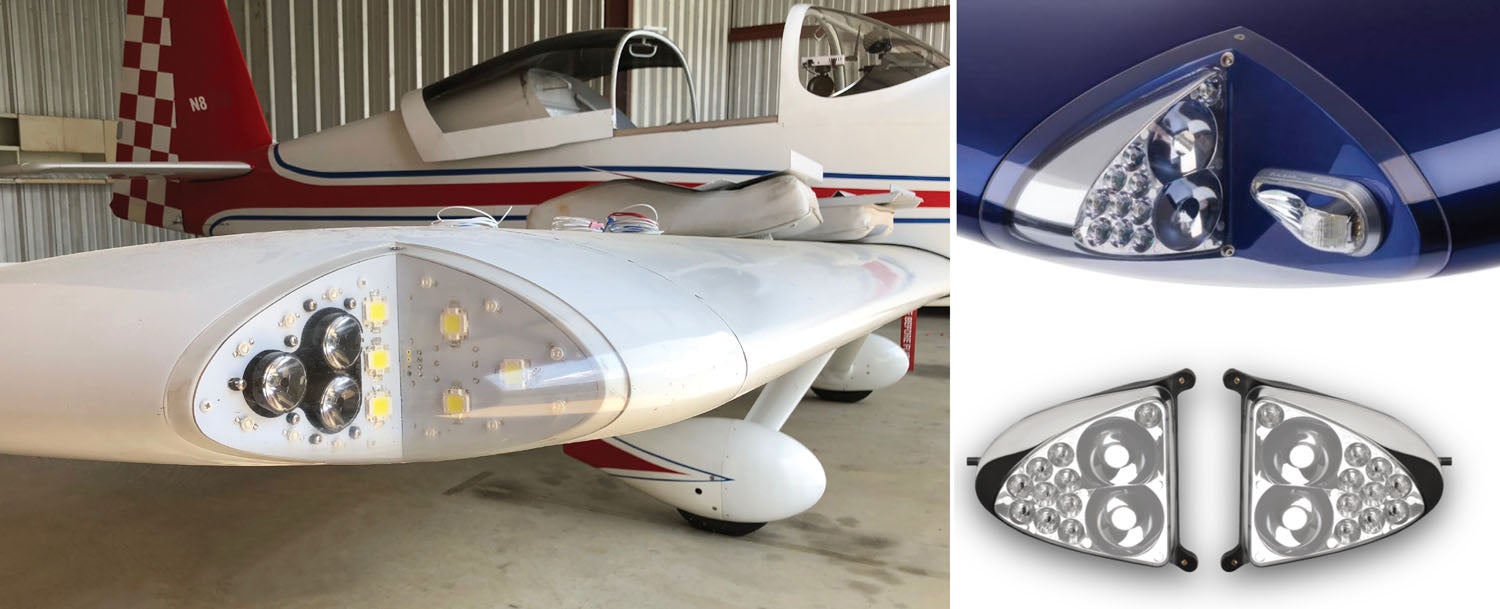
Landing Lights
In general aviation, PAR 36 and PAR 46 lights are by far the most common. The “PAR number” is simply the diameter in eighths of an inch, so a PAR 36 is 4.5 inches in diameter and the PAR 46 is 5.75 inches. Typically, when a manufacturer says their landing light is a drop-in replacement for a PAR 36 or PAR 46, it means both the outer diameter and thickness are to a certain spec, but also that the rear face of the housing won’t protrude more than a certain amount.
For lights in wingtips or deep cowlings, this depth isn’t a concern, but it’s worth double-checking what’s available in your installation before ordering. Other manufacturers, like Flyleds, recognize that many new installations are going into either wingtips or wing leading edges, where depth isn’t an issue, so the housings can be made into whatever shape works best for the light.
A note on some of the ratings you’ll see in the table. When a manufacturer lists a luminance value it’s generally in the very best-case situation—and why wouldn’t it be? But LEDs create heat when they work, and every light has some form of power- and heat-management circuitry at work. There are trade-offs in how hard to work the LED—the more you do, the brighter the beam—versus longevity. If you can get heat out of the assembly, you can work the drivers harder, but packaging a light into a familiar PAR package can expose a few compromises there.
Let’s take a look at the offerings from the leading manufacturers.
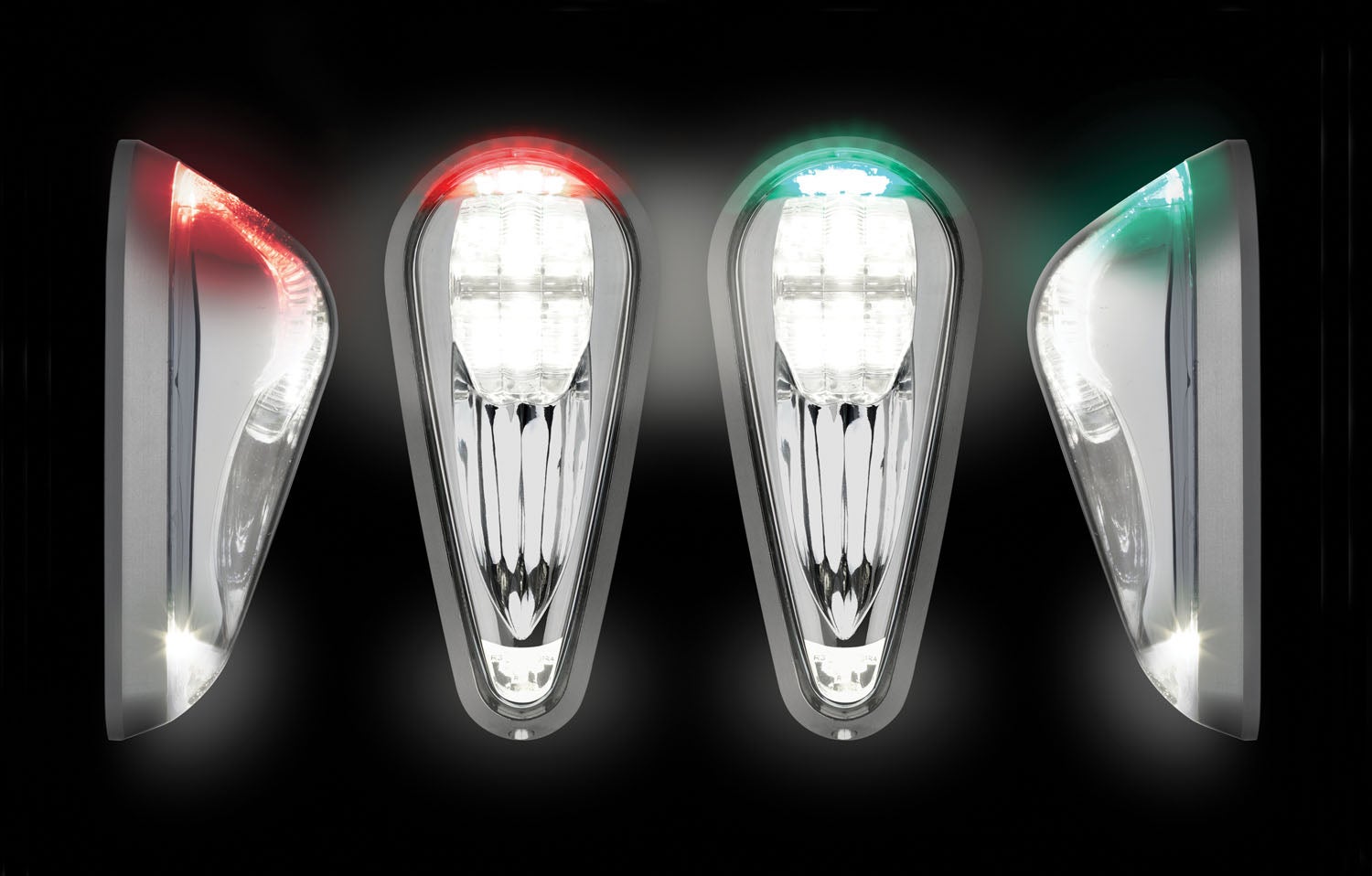
AeroLEDs
If you ask AeroLEDs’ Ryan Edmark what sets the company apart, he’ll tell you, “It’s all about performance. If we’re going to design a light, we’re going to do the absolute best we can. Performance is the backbone for AeroLEDs.” This approach is reflected in both the performance stats for the devices and the price points, which land at the top end of the range.
For position lighting, the AeroLEDs lineup is anchored by the Pulsar series. The straight Pulsar lamps are three-way units (strobe/nav/rear-facing recognition) with a footprint similar to the legacy A600 strobes, meaning they’ll go on without a ton of bodywork needed. (For more on dimensions and power consumption, see the table below.)
From there, the Pulsar lineup includes the N, NS and NSP, which fit the smaller A650 footprint. It’s easy to decode. The N is navigation only, NS adds the strobes and the NSP includes a rear position light. All of these units can be mounted inside a wingtip (as on an RV, for example) though you’re better off getting the N or the NS since the rear-facing light wouldn’t be visible. All Pulsar-series lights have nicely rendered aluminum mounting brackets that screw to the wing, while the lights are held on by a combination of pegs and slots and a single set screw, so it’s possible to remove the light without gaining access to the inside of the wingtip. Strobe models include a sync wire so that the wingtip strobes are coordinated left to right (and to the rear if a taillight is mounted). As mentioned, the Pulsar series lives at the high end of the price range, starting at $929 per pair.

AeroLEDs has been active in landing-light development, too. The Sunspot series has grown with the addition of the Equinox, but it’s grounded in the Sunspot 36-4000 and 36 LX/HX models. Each of these is available with either landing or taxi-beam optics, and most versions of the 4000 and HX models have a built-in wig-wag feature. (In all cases, the flashing can be coordinated between two landing or taxi lights for maximum effectiveness.) The 4000 kicks out 150K candela compared to 65K candela on the Sunspot 36 LX/HX. (Candela with the taxi models is lower, as you’d assume.)
AeroLEDs’ newest entry is the Equinox, just released in a PAR 36, 14-volt format. The Equinox uses dual-element LEDs to provide 150K candela in landing-light mode and 50K candela in taxi mode; the landing light dispersion is a 20° x 20° pattern, with the taxi spreading out to a 20° x 45° pattern. Worth noting is that most of the traditional-form-factor lights (wingtip, PAR-series) from AeroLEDs are TSO approved.
The airplane-specific model from AeroLEDs is the AeroSun VX, for the most popular RV models—it’ll fit the RV-6/7/8 with the W-715-1 wingtip or the RV-9/10/14 with a conversion kit. The AeroSun has separate taxi and landing circuits (and is expected to be wired for either/or) as well as intrinsic wig-wag features.
Aveo Engineering
A pioneer in LED lighting for homebuilts, Aveo has a wide range of products in this sphere. For the nav/strobe light options, Aveo’s Ultra DayLite and Ultra Embedded DayLite are the most compact, with a footprint just shy of 4 inches front to back and a height of less than 2 inches. The “embedded” version has no rear-facing light, making it suitable for wingtip installation. The larger-footprint premium offering is the Andromeda, which is about the same size as the combined three-way legacy nav/strobe systems but is just more than 1 inch tall. It’s available in both 14-volt and 28-volt versions.
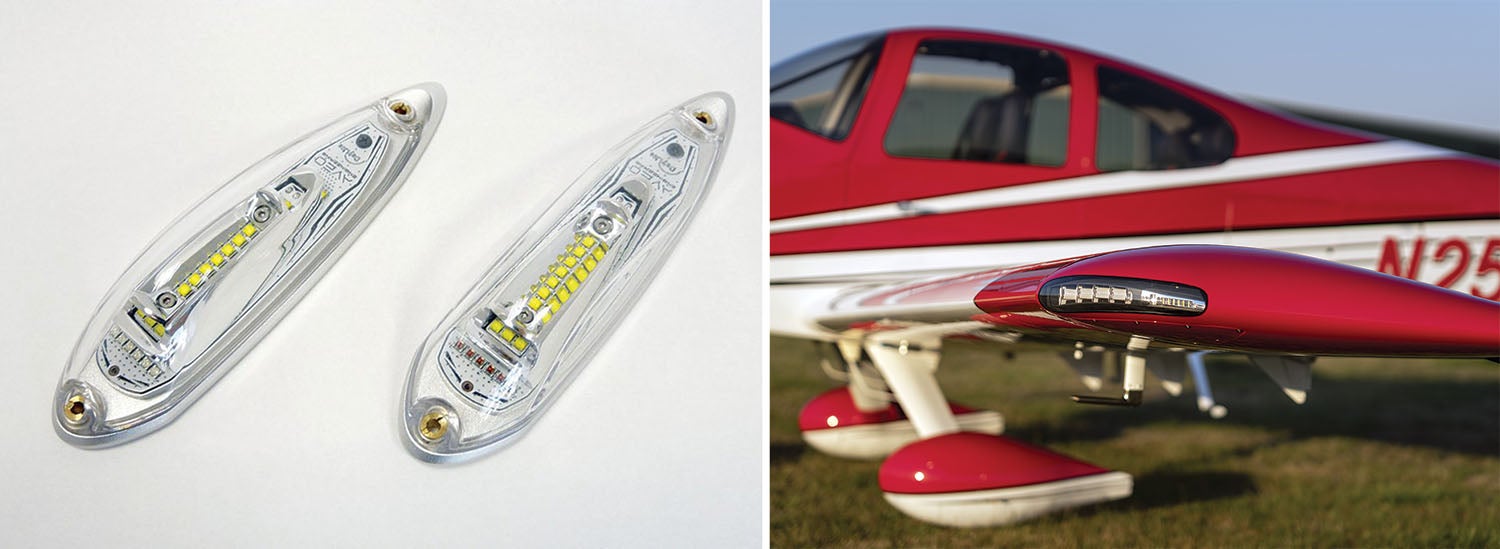
Aveo has a lower-cost wingtip alternative in the PowerBurst NG, which is about an inch shorter (front to back) than the legacy A650 footprint and just a little over an inch tall. The PowerBurst is available in 14-volt versions only.
Aveo’s most impressive product may be its ZipTips. These are replacement wingtips for Van’s RV models that include embedded landing and taxi lights, side-firing strobes and nav lights. As expected, the system has an integrated wig-wag feature. The tips also include the rear-facing white position light, so no taillight is required. They run just under $3000 for the set.
On the landing-light side, Aveo has the Hercules NXT and Atlas NXT. The Hercules is a PAR 36-size lamp with two sets of LEDs, one for taxi and one for landing. Ten elements illuminate for landing and four, behind special diffusing lenses, light for taxi; they can be operated independently or together. The Atlas is a smaller version that affords more mounting flexibility if you’re not replacing a conventional PAR-sized bulb.
Flyleds
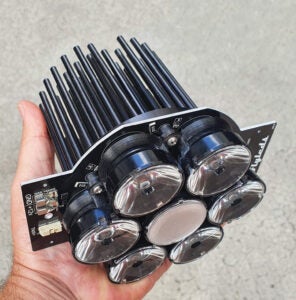
Flyleds is headed by Australian Paul McVitty, who spent four years of weekends helping a friend build an RV-10 and recently retired from 32 years as an engineer for Australia’s biggest phone company. Both McVitty and his friend were convinced they needed the brightest possible LED lighting for conspicuity as well as safety flying at night. “I did the research and came up with quite a few designs,” he says, one of which ended up on his friend’s RV-10. “He kept saying I had to produce these as a kit for other builders.”
Since those early days, McVitty says he’s sold about 1000 of the position and strobe-light kits, and now his lineup includes several different configurations of RV-centric lighting systems. (For more on the installation experience, read Myron Nelson’s Out of the Blue column.) The Flyleds product line is a good example of the building-block philosophy. The strobe and nav lights are part of boards inserted into the forward wingtips of RVs. There are a handful of other applications, but RVs are the company’s main channel—meaning you’ll need to add a taillight for full-circle illumination. You’ll also need a soldering iron, since the systems are sold as builder-assembled kits. (If you’re phobic about electronics, the systems can be ordered preassembled for a fee.)
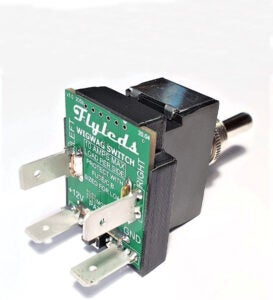
McVitty added landing lights later on and has several options, including configurations ranging from a single lamp through seven modules. The latest landing light is the Seven Stars, which has seven LEDs in a circle with a set of very long, prong-like heat sinks protruding from the back. For this reason, even though some of the lights might fit the basic contours of a PAR-style light, they’re all really designed for wingtip or wing-leading-edge installation, where depth isn’t generally a concern. McVitty says that the heat sinks are a key reason his lights are so bright; they can effectively shed the heat when run hard. He rates the Seven Stars at 9000 lumens and converts that to 588K candela.
While most of the Flyleds are set up for single circuits—the company offers its own wig-wag module as an option—the Seven Stars and both quad-light systems can be wired for a separate taxi circuit and those lamps fitted with a diffused lens. There’s a version tailored for taildraggers where the taxi light can be adjusted independently from the landing-light focus. McVitty sources the optics for the landing lights from Finland; the original application was for overhead surgery lights. This results in an 8° beam before any diffusers are added. Finally, while it’s certainly possible to make several of Flyleds’ products work on aircraft other than RVs, that’s McVitty’s market focus at the moment.
WAT (Whelen Aerospace Technologies)
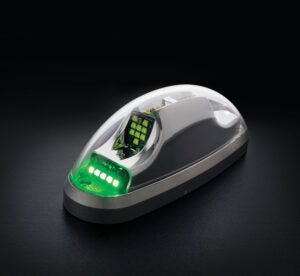
The company formerly known as Whelen is generally known as WAT—watt, get it?—has been doing anticollision lights for, oh, a long time. In the LED realm, WAT leverages its huge presence in lighting and the ability to manufacture to TSO specs throughout the line. Generally speaking, even those devices not explicitly stated as having TSO approval are built from TSO-quality components on the same assembly lines as the certified stuff, says WAT.
WAT’s current lineup for wing-mounted nav/strobe lights is comprised of two essential tiers. The Blaze and MicroBurst Plus models are aimed at the Experimental market and are less expensive. An upgrade is the Orion series, which comes in several form factors and lighting configurations.
The Blaze is a teardrop-shaped unit with nav/strobe/recognition lighting and a footprint that mimics the A650. It is described as “low drag and lightweight for LSA” and Experimentals. Current draw is less than half an amp each for the nav lights and just over 2 amps for the strobes. The Blaze can be mounted without wiring changes from a conventional strobe system once the high-voltage power supply has been removed. Like all good systems, the Blaze has a sync line so that strobes on both wingtips are in lockstep. Think of the MicroBurst Plus as a slightly smaller, slightly lower cost stablemate to the Blaze.
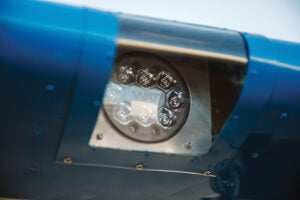
At the top of WAT’s range you’ll find the Orion series. The Orion 650 is a nav/strobe unit only while the 660 adds the rear-facing recognition light—both the 650 and 660 are built with an A650-compatible footprint (the smaller one). WAT has built these lights with independent front and rear strobe modules whose illumination patterns converge to create full 180° coverage on either side of the airplane. For fully embedded lights in the wingtip, there’s the Orion 650E, while the Orion 600 is a good choice to replaces A600-footprint lights.
WAT’s best landing-light choices are the Parmetheus Plus and, the latest entry, the G6. WAT’s Jeff Argersinger says the new G3 benefits from the fast march of LED technology, which is why it’s both relatively inexpensive and powerful, and represents a better value than earlier offerings. The G3 comes in both PAR sizes and can be fed by either 14- or 28-volt systems. Eight LED modules reside in custom optics and provide, according to WAT, 2.5 times more light than the previous lamp. According to the company, it makes 135K candela at startup on less than 4 amps. The original Parmetheus Plus clocks in at about 60K candela (after five minutes) and can be purchased in either a 14- or 28-volt version as well as in landing- and taxi-light configurations. WAT leaves it to builders to do their own wig-wag circuitry.
Wrap Up
LED lighting has become the technology of choice for homebuilders. If you’re creating an airplane that has model-specific lighting applications, that’s fine. The caveat here is that technology changes over time and very specific installations may require a rework should the original lighting supplier update its wares or, heaven forfend, go out of business. And you usually can’t get replacements in the field, something to consider for the future of your homebuilt.
Nav and Strobe Lights
| Model | Type | Dimensions (L x W x H) |
Weight (oz a.) |
Input Voltage | Nav Light Current (amps @ 14v) |
Strobe Current (amps @ 14v) |
Price (pair) | Notes |
|---|---|---|---|---|---|---|---|---|
| Aveo Engineering | ||||||||
| Powerburst NG | N S R | 4.5 x 1.3 x 1.0 | 2.3 | 9-18 | 0.2 | 2 | $459 | Non TSO’d |
| Ultra DayLite | N S R | 3.9 x 1.8 x 1.3 | 3.4 | 9-36 | 0.4 | 1.9 | $835 | Non TSO’d |
| Ultra DayLite Embedded | N S | 3.9 x 1.8 x 1.3 | 3.4 | 9-36 | 4 | 1.8 | $835 | Non TSO’d |
| Andromeda DayLite | N S R | 5.3 x 1.3 x 1.1 | 3 | 14 or 28 | 0.3 | 1.7 | $800 | Non TSO’d |
| AeroLEDs | ||||||||
| Pulsar | N S R | 5.6 x 1.9 x 1.4 | 4 | 14 or 28 | 1.6 | 1.2 (9.9 peak) |
$1,250 | A600 footprint |
| Pulsar NSP | N S R | 4.0 x 1.9 x 1.5 | 3.8 | 14 or 28 | 1.3 | 1.3 (9.8 peak) |
$1,195 | A650 footprint |
| Pulsar NS | N S | 4.0 x 1.9 x 1.5 | 3.8 | 14 or 28 | 1.6 | 1.3 (9.8 peak) |
$1,150 | A650 footprint |
| Flyleds | ||||||||
| The Original | N S | RV wingtip internal | 7 | 14 | 1.8 | 1.5 | $249 | Req. assembly, taillight req |
| The Works | N S L | RV wingtip internal | NA | 14 | 1.8 | 1.5 | $599 | Req. assembly, taillight req |
| WAT (Whelen Aerospace Technologies) | ||||||||
| Blaze | N S R | 4.5 x 1.3 x 1.1 | 3 | 14 | 0.8 | 4.3 | $470 | Near-A600 footprint |
| Microburst Plus | N S R | 3.7 x 1.6 x 1.4 | 3.4 | 14 | 0.5 | 0.4 (2.4 peak) |
$369 | A650 footprint |
| Orion 650E | N S | Wingtip internal | 4.3 | 14 or 28 | 1.4 | 0.7 | $963 | TSO’d |
| Orion 650 | N S | 4.0 x 1.8 x 1.7 | 4.2 | 14 or 28 | 1.4 | 0.7 | $1,018 | TSO’d; A650 footprint |
| Orion 600 | N S R | 5.3 x 1.8 x 1.7 | 4.2 | 14 or 28 | 1.4 | 0.7 | $1,030 | TSO’d: A600 footprint |
N = Nav, S = Strobe, R = Recognition, L = Landing
Landing Lights
| Model | Type | Dimensions (L x W x H) |
Weight (oz) |
Input Voltage |
Input Current (amps @ 14v) | Candela | Lens Angle (°) |
Wig-Wag | Price | Notes |
|---|---|---|---|---|---|---|---|---|---|---|
| Aveo Engineering | ||||||||||
| Atlas NXT | L T | 3.6 x 2.0 | 13 | 9-36 | 2.7 L / 1.1 T |
124K L / 11K T | 9 L / 12 x 30 T |
Yes | $755 | Two intensities available, PAR 46 available |
| Hercules NXT | L T | PAR 36 | 15 | 9-36 | 2.7 L / 1.1 T |
149K L / 18K T | 10 L / 10 x 45 T |
Yes | $965 | Two intensities available, PAR 46 available |
| AeroLEDs | ||||||||||
| Equinox | L T | PAR 36 | 11.5 | 14 or 28 | 7.9 | 150K L / 50K T | 20 L / 20 x 40 T |
Yes | $850 | PAR 46 available soon |
| Sunspot 36-4000 Landing | L | PAR 36 | 11.5 | 14 or 28 | 6.8 | 150K | 20 | Yes | $650 | Landing-light beam pattern |
| Sunspot 36-4000 Taxi | T | PAR 36 | 11.5 | 14 or 28 | 6.8 | 50K | 20 x 40 | Yes | $650 | Taxi-light beam pattern |
| Sunspot 36 LX/HX | L | PAR 36 | 11.5 | 9-40 | 3.2 | 65K | 20 | Yes | $349 | Landing-light beam pattern |
| Sunspot 36 LX/HX | T | PAR 36 | 11.5 | 9-40 | 3.2 | 15K | 20 x 70 | Yes | $349 | Taxi-light beam pattern |
| AeroSun VX | L T | RV Wingtip Internal | 31.0 (per pair) | 14 or 28 | 8.6 L | 120K (per pair) | 20 | Yes | $805 | See text for applications |
| Flyleds | ||||||||||
| Seven Stars | L T | RV Leading Edge | 24 | 14 | 8 | 588K | 8 | Opt. | $299 | Unassembled |
| Combo Leading Edge |
L T | Leading Edge | 15.5 | 14 | 4 | 250K | 8 | Opt. | $179 | Unassembled; one beam can be directed separately by as much as 20° |
| Quad Spotlight | L T | Leading Edge or Wingtip |
12 | 14 | 4 | 250K | 8 | Opt. | $169 | Unassembled |
| Six Pack | L T | Leading Edge or Wingtip |
15 | 14 | 6 | 144K | 8 | Opt. | $249 | Unassembled |
| WAT (Whelen Aerospace Technologies) | ||||||||||
| Parmetheus G3 | L or T | PAR 36 | 13 | 14-28 | 3.8 | 135K (L) | 20 | No | $299 | Separate landing and taxi models; PAR 46 available |
| Parmetheus Plus | L or T | PAR 36 | 8.3 | 14 or 28 | 1.4 | 60K (L) | 20 | No | $245 | Separate landing and taxi models; PAR 46 available |
L = Landing, T = Taxi






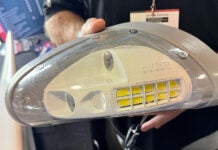






Hi, Marc! Thanks for including some the Aveo Engineering product line in your article. Please allow me to point out the following:
The Andromeda Nav/Strobe/Position light IS available in a 28 volt version, and has a list price of $795 per pair, not $800.
The Ultra series of Nav/Strobe/Position or Nav/Strobe has a list price of $795 per pair, not $835.
The Atlas NXT has a list price of $725, not $755.
The PAR 36 Hercules NXT has a list price of $895, not $965.
Although the bulk of Aveo’s business is centered on military OEMs, commercial aircraft and civil jets, they have recently introduced the high performance, highly affordable “JP” line of airframe lighting, a no-frills selection of lights perfect for builders on a budget. Please let me know if you’d like more information on the experimental or certified Aveo product line.
Marc, some how XeVision was inadvertently missed in this article.
https://www.xevision.com/led_aircraft.html
XeVision unveiled in 2021 (8 years in R&D), our XeTREME output line of Landing and Taxi LED’s which are 2X to 3X more powerful than any other PAR-36 form factor LED currently on the market worldwide. Offering SUSTAINED output (non dimming / active cooled) of 320,000+ Cd / CP & about 11,000 Lumens. Very effective long distance landing lighting with 1 LUX – @1/3 mile, 1/2 LUX – @1/2 mile. Includes a strobe mode for optimal bird & aircraft collision avoidance. Significantly More effective than wig-wag. Repairable, modular, upgradeable ( future proof ). Optical chamber nitrogen flooded and sealed, hardened AR glass lens, black anodized. Certified documented Lab performance data and (FAA) RTCA DO160G certified. 5 year / 2000 hour standard warranty.
For 20 years XeVision had only been offering HID (35-90 watt) Landing, Taxi & Recognition lighting used by major Aircraft manufacturers, Military -(NATO, USA, Israel), homebuilders & General Aviation.
XeVision has been in high performance aviation lighting longer than all listed here except Whelen / WAT. Until XeVision’s new XeTREME LED’s arrived, nothing on the LED market could perform as well as HID’s, as a high powered landing light. Hopefully you can include our products in future LED or HID comparisons.
Perfect timing for my build. Good article covering the main players.